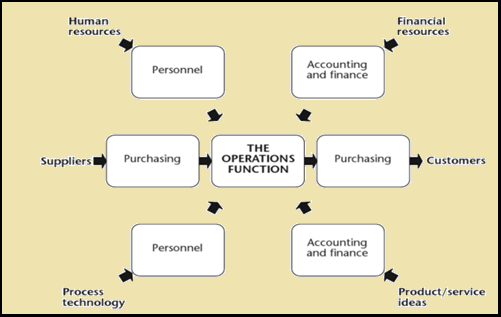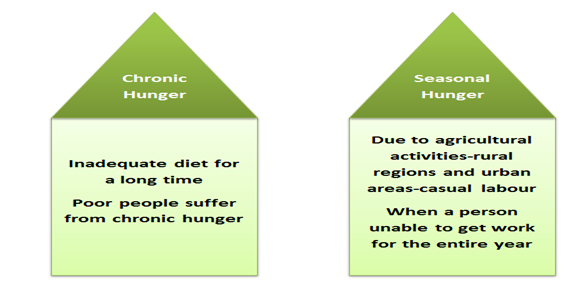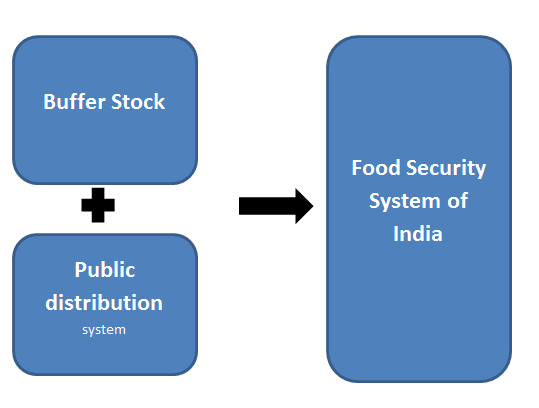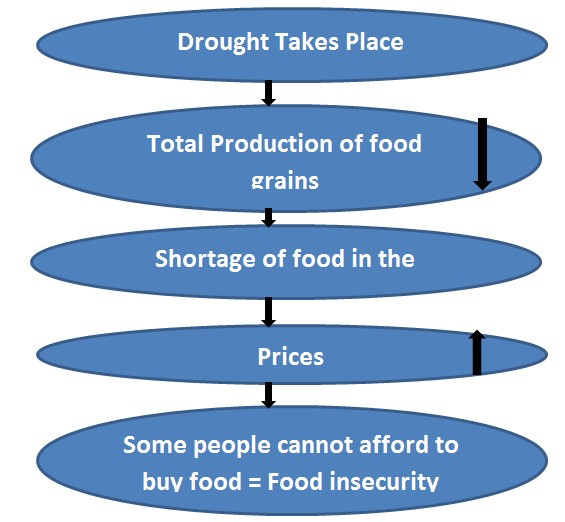Issues of buffer stocks and food security
In present scenario, there is major problem in staple food distribution system due to the price volatility of commodity. The shortage of staple food around the world has adversely impacted on the economics, political and social crisis because of food security reason.
Public sector food grain stocks are significant support of India’s food policy and food security. They have three important societal goals.
- To provide space for effective implementation of minimum support price for rice and wheat through procurement mechanism.
- To maintain price stability arising out of year to year fluctuations in output or any other exigency.
- As a source of supply for public distribution system and various other schemes to sustain food and nutrition security particularly of economically weaker sections.
The Food Corporation of India is the key agency for procurement, storage and distribution of food grains. In addition to the requirements of wheat and rice under the targeted public distribution system, the Central Pool is essential to have sufficient stocks of these in order to meet any emergencies such as drought/failures of crop, as well as to allow open market intervention if price increases (Ratna Kumari Bandila, 1992).
Buffering is a means by which an organization attempts to ensure that it has safe level of stocks in addition to its base stock. Maintaining a buffer stock is an important constituent of the Government’s food policy. The buffer stock gives the basic and most flexible instrument for moderating short-term effects of supply or production shortfalls. The concept of a buffer stock was first familiarized during the 4th Five Year Plan (1969-74) and a buffer stock of 5 million tonnes of food grains was envisaged. The way, in which many businesses approach to the concept of buffering, it reflects the operation management has developed over the past decades. In past business believed that it was unable to deal with fluctuation which occurred external to the organization. Physical buffering had to be in place to ensure that demand could be satisfied. This was the standard price regardless of the fact that the businesses might be able to increase its output to cope with an increasing demand (Jonathan Sutherland, 2015).
Physical buffering system (Source: Jonathan Sutherland, 2015)

Operation managers were not considered to be expert enough to deal with organizational issues outside their immediate area of involvement. In this reference, human resource managers were deployed to deal with employees who would work in operation. These managers buffered from outside by supporting functions within organization.
External buffering system Source: Jonathan Sutherland, 2015)

Buffer stocks have come under frequent outbreak on three grounds. The level of stocks is too high in relation to the buffer stock standards which is causing huge cost in terms of storage, interest on value of produce, and wastage. It is said that price can be stabilized through trade rather than stocks and the former is found to be much cheaper than latter. It is also debated that buffer stocks for absorbing shocks due to production variation were reasonable when India did not have enough foreign exchange reserve to maintain excessive stocks held by public agencies. The problem is not with the buffer stock but with storage capacity and irresponsible management of food grains.
The Buffer norms are the minimum food grains the Centre should have in the Central pool at the beginning of each quarter to meet requirement of public distribution system and other welfare measures. The last changes in the Buffer norms were done in July 2013.
Major objectives of Buffer Stocks: The buffer stocks are required to feed targeted public distribution system and other welfare schemes, guarantee food security during the periods when production is short of normal demand during bad agricultural years, stabilize prices during period of production shortage through open market sales. India is in comfortable position in the buffer stock. However, it has raised the questions over the storage capability of the FCI and contaminated grains in the open godowns in the country. The issue of storage had also been highlighted to the Supreme Court, which recommended that government should allocate the grains free to the poor section of society. The problem is huge, but government does not have immediate solution. The FCI has to increase the storage capacity to accommodate the record procurement.
Current Buffer Stock Policy of Government: The current buffer norms were reviewed in January 2015. According to the new norms, the central pool should have 41.1 million tonnes of rice and wheat on July 1 and 30.7 million tonnes on October 1 every year. These limits were 32 million tonnes and 21 million tonnes earlier. The stocking norms for the quarters beginning January’1 and April’1 have been revised only slightly. Main drivers for increased buffer stocks were increased off take from the targeted public distribution system and also enactment of National Food Security Act. It was observed that Food Corporation of India buys almost one third of the total rice and wheat produced in the country at minimum support prices. It does imply that denying to any farmer who wants to sell his produce at MSP. But then it also needs to maintain an excessive, incontrollable and monetarily troublesome food inventory. Previously, once the buffer norms were met, cabinet approval was needed to sell any part of it in the open market. But in January 2015, it is revised. The current policy is that Food Ministry is authorized to dispose the surplus stock into open market without seeking cabinet approval. This was a major policy decision and it was needed to resolve the problem of burdensome inventories at Food Corporation of India and misrepresentation created in market.
The maintenance of a buffer stock is also important to ensure national food security. Stocks mainly of rice and wheat are commonly maintained from year to year at a substantial cost in order to effectively take care of variations in domestic food grain production. These variations occur quite regularly due to climate and man-made factors. Buffer stocks are created from the domestic food surpluses available in years of high production. They are also built and maintained through imports as and when required. The optimum size of the buffer stocks at any point of time is based on the proposals of expert committees appointed for the purpose by the government from time to time.
In the context of India, buffer stocking of food grains is theoretically seen as a mechanism to deliver strategic food and agricultural domestic support policies, but in terms of its effectiveness to accomplish its objective, there is a growing consent, both domestically and internationally, that the food stocking programme has been not just expensive but also indiscreetly wasteful. In India, the prices of agricultural products such as wheat, cotton, cocoa, tea and coffee tend to alter more than prices of manufactured products and services. This is mainly due to the volatility in the market supply of agricultural products coupled with the fact that demand and supply are price inelastic. In order to manage the fluctuations in prices, it needs to operate price support schemes through the use of buffer stocks. Buffer stock schemes stabilize the market price of agricultural products by buying up supplies of the product when harvests are copious and selling stocks of the product onto the market when supplies are low.
Problems with buffer stock schemes:
Theoretically, buffer stock schemes should be lucrative, since they buy up stocks of the product when the price is low and sell them onto the market when the price is high. Nonetheless, they do not often work well in practice. Evidently, perishable items cannot be stored for long time and can therefore be immediately ruled out of buffer stock schemes.
Other issues related buffer schemes are:
Cost of buying excess supply can cause a buffer stock scheme to run out of cash. A guaranteed minimum price might cause over-production and increasing excesses which has economic and environmental costs.
Setting up a buffer stock scheme also necessitates a significant amount of start-up capital, since funds are required to buy up the product when prices are low. There are also high administrative and storage costs to be considered. The success of a buffer stock scheme depends on the capability of people who manage a scheme to correctly estimate the average price of the product over a period of time. This estimate is the scheme's target price and obviously determines the maximum and minimum price boundaries. But if the target price is considerably above the correct average price then the organization will buy more produce than it is selling and it will ultimately run out of money. The price of the product will crash as the excess stocks built up by the organization are dumped onto the market.
On the contrary, if the target price is very low then the organization will often find the price rising above the boundary, it will end up selling more than it is buying and will eventually run out of stocks.
Problem in using buffer stock

Food security:
To enhance food security to the people is major an issue and also highly significant welfare state. For humans, food is basic necessity. In spite of remarkable food production in recent decades, such that enough food is available to fulfil the basic needs of every person, complete food security has not been accomplished. With reference to India, where millions of poor suffer from persistent hunger and malnutrition.
Hunger leads to food insecurity

The notion of food security has progressed over the last few decades. Academics, policy-makers and activists have debated on what constitutes food security and how it can be ensured at the global, regional, state, household and individual levels. Different approaches have been formulated to tackle the problem of hunger and food insecurity. According to the Food and Agricultural Organization (FAO), food security emerges when all people at all times have physical and economic access to adequate, safe and nourishing food to meet their nutritional needs and food preferences for healthy life. Food security has three important aspects that include availability of food, access to food, and absorption of food.
Food security is a multi-dimensional conception and extends beyond the production availability, and demand for food. There has been revolutionary changes in the concept of food security from mere macro level availability and stability to micro level household food insecurity.
People without secure access to food are improbable to progress economically or to contribute indirectly to the welfare of other populations through economic trade, cultural exchange, or social interaction. Therefore, lessening hunger and poverty is in the long-run interest of the human development. Hunger is chronic under nutrition that make people susceptible to disease and their members unable to lead active and productive lives. Food security requires ensuring that food grains are physically and economically accessible to households. Physical accessibility of food grains in India for the poor mainly depends upon the public distribution that operates to a network of fair price shops (FPS). Economic accessibility depends upon the buying power of the people, which is mainly affected by two factors, the price of food grains and the income of the people. A state of food insecurity subsists when the members of a household have an inadequate diet for part or all of the year or face the possibility of an inadequate diet in the future.
Many experts and scholars explained food security as the state in which all persons obtain a nutritionally adequate and culturally acceptable diet at all times. It is a fact that all people, especially the most vulnerable, have distinguished and secure access to the quality and quantity of culturally appropriate food that will fully support their physical, emotional and health. It entails that all people in society have access to highly nutritious food at all times. It is necessary that food is available to all people, at all times, in order to have an active, healthy life.
The World Food Summit held in 1996 in Rome, which held in the period of increasing international concern over food security gave a new motivation to struggle for food security by highlighting major food issues. There are numerous grounds for food insecurity such as population growth and rising food transportation and agricultural cost. The Rome Declaration on World Food Security was organized by the Food and Agricultural Organisation. It elaborated food security as, “when all people, at all times, have physical and economic access to sufficient, safe and nutritious food to meet their dietary needs and food preferences for an active and healthy life.” It is established that to realize food security, there should be enough food for people and they have the purchasing power to access the food so available, and the food available is culturally acceptable. It should fulfil passable nutritional value for healthy life.
Food security has four interrelated elements. These are availability, access, utilisation and stability.
Availability is about food supply and trade, not just quantity but also the quality and variety of food. Improving availability requires sustainable productive farming systems, well managed natural resources, and policies to enhance productivity.
Access includes economic and physical access to food. In order to improve access, there should be better market access for smallholders allowing them to generate more income from cash crops, livestock products and other enterprises.
Utilisation is about how the body uses the various nutrients in food. A person’s health, feeding practices, food preparation, and diversity of their diet and intra-household distribution of food all affect a person's nutrition status. There is a need to enhance nutrition and food safety, increasing diversity in diets, reducing post-harvest loss and adding value to food to improve utilisation.
Stability is about being food secure at all times. Food insecurity can be momentary with short term stocks the result of a bad season, a change in employment status, conflict or a rise in food prices. When prices of commodities increase, it is the poor who are most at risk because they spend a much higher portion of their income on food. Social networks can play an important role is supporting people through transitory food insecurity.
Food schemes in India:
- Entitlement Feeding Programmes
- ICDS (All Children under six, Pregnant and lactating mother)
- MDMS (All Primary School children)
- Food Subsidy Programmes
- Targeted Public Distribution System (35 kgs/ month of subsidised food grains
- Annapurna (10 kgs of free food grain for destitute poor)
- Employment Programmes
- National Rural Employment Scheme (100 days of employment at minimum wages)
- Social Safety Net Programmes
- National Old Age Pension Scheme (Monthly pension to BPL)
- National Family Benefit Scheme (Compensation in case of death of bread winner to BPL families)

To accomplish food security is highly important for India where more than a-third of its population is estimated to be undeniably poor, and as many as one half of its children have suffered from malnourishment over the last three decades. Several important issues have emerged in the framework of food security in India. These are as under:
- The liberalization of the economy and its impact on agriculture and food security.
- The establishment of the WTO and the agreement on Agriculture.
- Climate change and its impact on food production and prices.
- The prevalence of hunger and poverty coexisting with high levels of food stocks.
- The introduction of the targeted Public Distribution System.
- The "Right to Food" campaign.
- The National Food Security Bill.
These issues have posed severe challenges for food security in India.
Nevertheless, the achievement of macro level food security and the visible improvement in per capita consumption, the country is still home to a-fifth of the world’s malnourished population. The extent and nature of food insecurity can be mainly classified as under:
- Chronic Food Insecurity
- Nutritional Insecurity
- Food Insecurity caused by lack of Food Absorption
- Transitory Food Insecurity.
There are several factors, both on the supply side, as well as the demand side responsible for chronic food insecurity. The most important supply side determinants of food insecurity are the level of domestic food production, the imports of food and the distribution of food. The determinants on the demand side are the growth of population, the buying capacity, product prices/subsidies and the extent and effectiveness of helpful social programmes and schemes such as the ICDS, the Mid Day Meal scheme, Food for Work Programmes, and Rural Wage Employment Programmes. Drought, flood and other disaster hugely impact on food insecurity.
Drought impact on food insecurity

It is summarized that the building and maintenance of buffer stock is an important feature of national food policy primarily to ensure stability in supplies and prices over the year as well as to meet contingencies arising from drought and flood. For building of buffer stock, it is necessary that government itself procure the food grains. The agency, Food Corporation of India was established on the recommendation of the Jha committee (Ratna Kumari Bandila, 1992). It came into existence in 1965. It is principle agency for procurement and distribution.
When appraising food security, it is concluded that Food and nutrition security immensely affects human health and wellbeing, as well as economic and political steadiness. As the world’s population grows and becomes wealthier, food production will need to upsurge.

